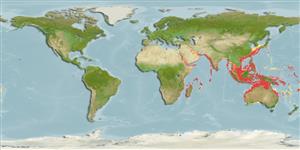Common names from other countries
Issue
Species spelling Eschmeyer, pers. comm.
Environment: milieu / climate zone / depth range / distribution range
экология
морской ассоциированный с рифами; пределы глубины 7 - 200 m (Ref. 11298). Tropical
Indo-Pacific: East Africa, throughout the Indian Ocean to the Indo-Australian Archipelago and New Caledonia, north to southern Japan.
Size / Вес / Возраст
Maturity: Lm ? range ? - ? cm
Max length : 15.0 cm TL самец/пол неопределен; (Ref. 11298); common length : 10.0 cm TL самец/пол неопределен; (Ref. 3322)
членистые (мягкие) лучи спинного плавника (общее число) : 81 - 87; членистые (мягкие) лучи анального плавника: 61 - 65; позвонки: 24. This species is distinguished by the following characters: body deeply ovoid; caudal fin with a pair of black blotches, arranged between the third and fourth fin rays from upper- and lowermost rays in the fin; the ocular-side pectoral fin is not elongate, and no sexual differences in its length; gill rakers are very short, not serrate (Ref. 126076).
Description. D 81-87; A 61-65; pectoral-fin rays on ocular-side 10-12, blind-side 8-10; caudal-fin rays 3 + 11 + 3; pelvic-fin rays on ocular-side 6, blind-side 6; lateral line scales 40-45; gill rakers 0 + 5-7; vertebrae 10 + 14 (Ref. 126076).
Found on sandy and muddy areas of the continental shelf. Feeds on crustaceans, polychaetes, and other benthic animals (Ref. 9824). Marketed fresh and sometimes dried (Ref. 9824).
Life cycle and mating behavior
Maturities | размножение | Spawnings | Egg(s) | Fecundities | личинки
Amaoka, K., E. Mihara and J. Rivaton, 1993. Pisces, Pleuronectiformes: Flatfishes from the waters around New Caledonia. - A revision of the genus Engyprosopon. p. 377-426. In A. Crosnier (ed.) Résultats des Campagnes MUSORSTOM, Volume 22. Mém. Mus. natn. Hist. nat. (158):377-426. (Ref. 9558)
Статус Красного Списка МСОП (Ref. 130435)
Can't connect to MySQL database (fbapp). Errorcode: Too many connections
